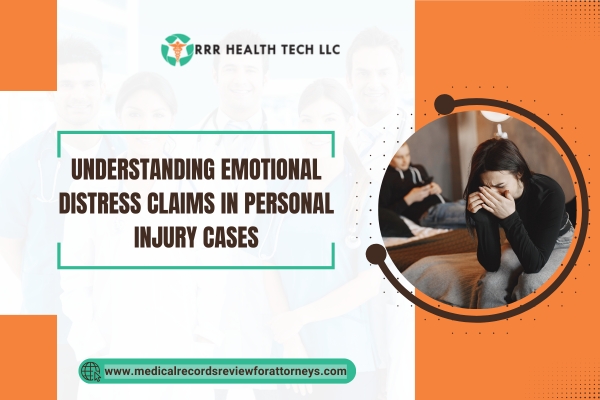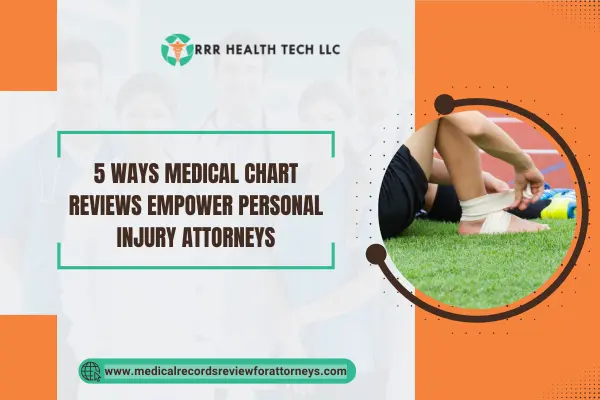
Introduction
Claims of emotional distress are drawn upon in coping with personal injury claims. It attempts to express how an injury sustained has affected the psychological aspect of a victim’s functioning in their life. The daunting task of managing such complex claims begins with understanding the emotional distress aspect of the victim, its legal side, and, importantly, the relevance of medical record evaluations. The primary focus of this article is to elaborate on emotional distress claims and mention medical record review services and how they can help attorneys provide robust claims.
What is Emotional Distress?
Tort law understands emotional distress as a mental agony suffered by a person due to an incident or series of incidents, including accidents and other traumatic experiences. People have experienced emotional distress in different ways such as feelings of apprehension or nervousness, sad feelings of depression, and posttraumatic disorder. For legal purposes, emotional distress torts are understood in the sense of being compensated for non-physical, non-monetary damages suffered as a result of having endured a great deal of suffering.
Types of Emotional Distress
- Negligent infliction of Emotional Distress (NIED): This results when the negligent act of the defendant puts the plaintiff in an emotional state.
- Intentional Infliction of Emotional Distress (IIED): A Person purposefully endeavors for another person to suffer immense emotional harm through a set of actions.
Legal Framework for Emotional Distress Claims
Elements of an Emotional Distress Claim
To successfully prove an emotional distress claim, the plaintiff must typically establish the following elements:
- The defendant acted in a way that was unreasonable or irrational in relation to the situation, which was caused by justification.
- The defendant’s conduct was with purpose or recklessness.
- The plaintiff has gone through a lot of emotional distress.
- There was a link between the defendant’s actions and resulting emotional distress of the plaintiff.
Statutory Considerations
This is not universal and differs between states, some states may not require any physical injury for emotional distress claims yearning for compensation. Disparities and intricacies must be considered by practicing attorneys when representing clients and understand that all jurisdictions are not alike.
The Role of Medical Record Reviews in Emotional Distress Claims
Importance of Medical Records
Medical records are first and foremost crucial in the placing of emotional distress claims as they help in evidencing the claim. They contain written material that informs about the psychological effect of an injury suffered such as diagnosis, treatment, and notes about the progress made. A comprehensive examination of medical records can achieve the following for attorneys:
- Demonstrate how long the plaintiff has been emotionally distressed.
- Relate the medical evidence to the incident in issue.
- Increase the substantiation of the claim.
How Medical Record Review Services Assist Attorneys
- Comprehensive Analysis: Medical record review services analyze extensive medical documentation to identify relevant information that supports emotional distress claims.
- Expert Testimony: These services can provide expert witnesses who can testify about the psychological impact of injuries, enhancing the case’s credibility.
- Case Preparation: By organizing and summarizing medical records, these services help attorneys present a clear narrative to judges and juries.
Common Challenges in Proving Emotional Distress Claims
Subjectivity of Emotional Distress
In all of the emotional distress claims, the most common and perhaps the biggest challenge is the emotional distress in the form of suffering. Unlike any physical injury, emotional distress is difficult to measure thus adequate weight must be carried to provide evidence for convincing.
Lack of Medical Documentation
In some cases, plaintiffs may not have sought medical treatment for their emotional distress, which can weaken their claims. Attorneys must encourage clients to document their experiences and seek professional help when necessary.
Strategies for Building a Strong Emotional Distress Case
Gathering Evidence
- Medical Records: All emotional distress claim cases should have access points in the form of records that demonstrate the plaintiff’s emotional changes after the cited event.
- Witness Testimonies: Gather evidence from family members, friends or colleagues in order to show that the plaintiff’s emotions have been altered.
- Professional Insight: Seek the aid of mental health practitioners with regard to the effects of the incident psychologically.
Utilizing Medical Record Review Services
Partnering with a medical record review service can streamline the process of gathering and analysing medical documentation. These services can help attorneys identify key pieces of evidence that may otherwise be overlooked.
Case Studies
Case Study 1: Jane vs. XYZ Corporation
Overview: For Jane, a factory worker, the sight of a work colleague sustaining fatal injuries at the workplace instilled an unbearable emotional scar within her.
Challenges: As a matter of fact, Jane was an initial avoidance seeker on therapy and this inefficacy at proving the level of psychological harm she had undergone.
Solutions: This lawyer assisted in adopting a medical record retrieval organization that focused on her subsequent mental healthcare where anxiety and depression were indeed treated. Later on, a psychologist endorsed this assertion through expert witness.
Case Study 2: John Smith vs. ABC Transport
Overview: Driver negligence led to ramification and a severe accident in which John Smith is stated to have severely traumatized and suffered from PTSD too.
Challenges: John was unable to explain the emotional consequence of the event as His first visits to the doctor evolved around his physical injuries resulting from the accident which saw a lack of proper documentation detailing his emotional stress.
Solutions: John’s attorney utilized a medical record review service to compile and analyze his medical history, identifying key visits where emotional symptoms were noted. The service also facilitated expert testimony from a psychiatrist who detailed the psychological effects of the accident on John’s daily life.
Conclusion
Claims of emotional distress are best handled to an understanding of legal doctrines as well as the psychological aspects of the case. Using medical record review services allows attorneys to improve their strategies on the case and allow clients to receive the intended level of compassion they deserved during legal proceedings. No doubt the changes in the legislative environment will make it necessary for lawyers to keep track of the innovations and use them in their work concerning all spheres of emotional distress claims.


